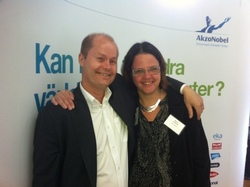Sustainable consumption
https://www.klimatsmart.se/images/news/bild250x187.jpg
Sustainable consumption is one of the greatest challenges we face:- environmentally, politically, practically and academically. At P&G we currently reach around 4.6 billion people, and have set a goal to reach at least 5 billion by 2015. Our long term sustainability vision is that we can do this with minimum environmental impact, which includes using only renewable materials, sustainably sourced, or recycled materials in our products and packaging, making our products in plants that use 100% renewable materials, with zero manufacturing waste going to landfill.
Thinking in sustainable consumption at P&G has followed the sustainability path throughout the last decades which we call as our key “Aha! Moments”.
Aha #1 realizing Sustainable production and consumption is 2 sides of the same coin. Initially production and consumption was generally treated as separate topics. Business community focused strongly on sustainable production, and the emerging concept of “eco-efficiency” made economic as well as environmental sense. Many “more with less”-products were developed, as well as P&G with compact detergents like Ariel Ultra (1987), claimed superior benefits but with less use of materials and energy. It took a while, but it gradually became evident that sustainable production needs to go hand in hand with sustainable consumption. Sustainable goals can never be met if the products are not consumed in the correct way.
Aha #2. Complex graph – simple message. Lifecycle Assessment (LCA) in the early 1990s enabled us to identify where the particular impact “hotspots” occur in each particular lifecycle. Early it became clear that in many products, the greatest impacts were often associated with the use, rather than the manufacture or disposal of the product. But it was first when we compile an overall LCA profile at the company level (2002), we really gained the insights that have strongly influenced our innovation, marketing and communications strategies. We learnt the energy profile, and hence also the greenhouse gas emission profile, of the whole company is driven by one specific area – namely the energy used by consumers to heat water and wash clothes in their own homes. The results showed that the energy consumption of P&G’s manufacturing operations was barely significant compared to the impacts of consumer use.
Clearly our biggest opportunity for energy and greenhouse gas reductions would come from product innovation to design detergents that would give superior cleaning in cold water and efforts in communications to change consumer behaviour to adopt lower wash temperatures. This led to a range of initiatives such as Ariel Coolclean, plus campaigns such as “Turn to 30”, along with industry wide programs such as the AISE “Washrite Code”. Coldwater washing continues to be a major focal point of P&G’s overall climate strategy. In 2010, we announced a goal of achieving 70% of all washing machine loads performed globally in cold water (30 degrees or lower) by 2020. We have made progress, today over 30%of consumers in the UK are washing at 30C compared to only 2% in 2002, and in the Netherlands it is over 50%!
Aha! #3. No trade-offs. Consumer research told us the mainstream consumer pool (75%) wants more sustainable products that are without any trade-offs in performance or value. This started P&G’s “No trade-offs” approach to delivering more sustainable products. Ariel Excel Gel – the super compact laundry detergent designed from scratch with a sustainability manifesto, a result of considerable R&D investment to ensure that it performed well in cold water; allowing consumers to wash at 15C, saving them energy and money, it used less than 50% of the ingredients of a non-compact product. To promote sustainable innovation with no trade-offs, P&G set a 5-year goal in 2007 to develop and market at least $Bill50 in sales of such “sustainable innovation products” with an improved environmental profile. Such products have to deliver at least a 10% improvement over the whole lifecycle in one environmental area and not be any worse in the other aspects, compared to the previous product. In other words, they need to deliver a significant and meaningful environmental improvement over the whole lifecycle. We are on course to deliver the $50 Bill goal this year.
So where did the Aha!s bring us? We will continue design the products that help consumers reduce their own energy and water consumption, and eventually ensure that zero consumer waste from our products and packaging goes to landfill. This vision is the lighthouse at the end of the road, the direction we are heading, and some aspects will take decades to achieve. But it will lead to sustainable production and consumption
Skrivet av Peter White på Hagainitiativets blogg.

 World Economic Forum har utsett Spowdi till Top Innovator i dess Smarter Climate Farmers Challenge.…
World Economic Forum har utsett Spowdi till Top Innovator i dess Smarter Climate Farmers Challenge.… Statkraft lämnade förra veckan in anmälan om samråd, enligt 12 kapitlet 6§ miljöbalken, för att…
Statkraft lämnade förra veckan in anmälan om samråd, enligt 12 kapitlet 6§ miljöbalken, för att… Stena Recycling lanserar en ny digital tjänst som ska ge företag mer kunskap om hur deras…
Stena Recycling lanserar en ny digital tjänst som ska ge företag mer kunskap om hur deras… Två innovationsprojekt har banat väg för en ny satsning inom mikromobilitet och logistik i…
Två innovationsprojekt har banat väg för en ny satsning inom mikromobilitet och logistik i… Bevarandet av den biologiska mångfalden och ekosystemen har inte bara ett egenvärde, utan är…
Bevarandet av den biologiska mångfalden och ekosystemen har inte bara ett egenvärde, utan är… Nu på lördag den 9 september kl. 10-16 kommer vi vara med på Skillebyholms höstmarknad! Vi…
Nu på lördag den 9 september kl. 10-16 kommer vi vara med på Skillebyholms höstmarknad! Vi… Genom att välja ekologiskt i matbutiken kan stora mängder bekämpningsmedel och konstgödsel stoppas.…
Genom att välja ekologiskt i matbutiken kan stora mängder bekämpningsmedel och konstgödsel stoppas.… En förhållandevis liten andel av den nordiska industrin är i dag cirkulär och det finns stora…
En förhållandevis liten andel av den nordiska industrin är i dag cirkulär och det finns stora… När ansökningstiden nu löpt ut för årets upplaga av Startup 4 Climate, en av Europas största…
När ansökningstiden nu löpt ut för årets upplaga av Startup 4 Climate, en av Europas största… Biokraft passerade i torsdags en viktig milstolpe när den nybyggda anläggningen för flytandegörning…
Biokraft passerade i torsdags en viktig milstolpe när den nybyggda anläggningen för flytandegörning…






